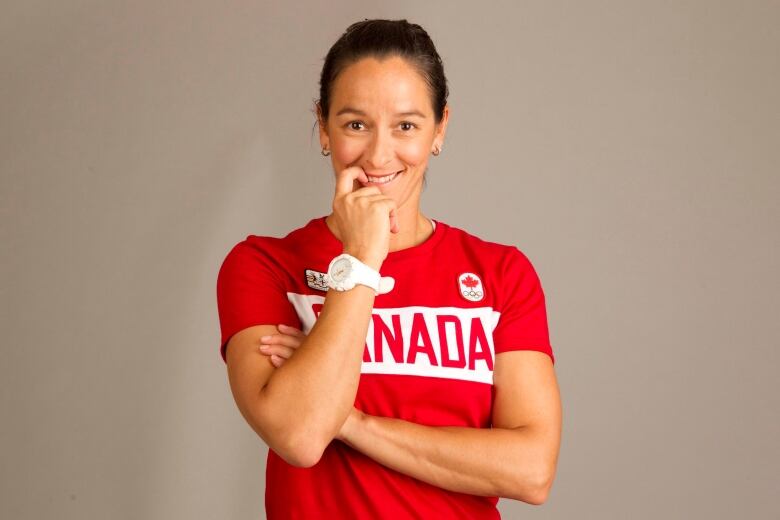Transporting athletes, volunteers and gear to Beijing no easy task during pandemic | CBC Sports
As a Canadian athlete at the 2012 London Olympics, Marie-Andree Lessard would stretch out her weary legs in the Canadian team lounge at the athletes village at the end of the day.
She and her Canadian teammates would watch the Olympic action on Canada’s big-screen TV in the lounge, or play cards or board games shipped from home to break up the monotony. She’d nibble on her favourite cheese that a Canadian staffer had happily made a London grocery run to purchase.
Lessard had no idea how much work had gone into making Canada’s athletes feel at home at the Games.
She knows now.
Lessard, who competed in beach volleyball in London, is now the Canadian Olympic Committee’s Director of Games, and so orchestrated the complicated transport of athletes, equipment and gear to the Beijing Games, and the elaborate setup once on the ground in China.
“I went to Sochi [2014 Winter Olympics] as an athlete service officer, I was a volunteer, and I built out the Ping-Pong table. And when athletes were playing on my Ping-Pong table, I was thinking ‘You have no idea how many hours I spent building that Ping-Pong table,”‘ Lessard said with a laugh.
“I think you only realize the full extent of the work that goes into it when you’re on the other side, [because] when you get there, it’s an empty building. But when you walk in as an athlete, you think that’s been there always, because it feels so homey.”
WATCH | Canadian athletes arrive at Beijing airport:
With the Winter Olympics set to begin in a few days, Canadian athletes have begun arriving in Beijing in preparation for the Games. 1:38
Flight arrangements
The global COVID-19 pandemic has thrown numerous wrenches into carefully laid plans. For example, the last site visit for the Canadian Olympic Committee was back in 2019, and so Lessard and her crew have had to rely on individuals on the ground to send photos and video of Canada’s space there.
“So, we have a good idea where we’re going into,” she said.
Finding flights, however, has been No. 1 on her list of logistical nightmares. Air Canada is providing two charter flights for most of Canada’s 215 athletes, and they’ll be grouped together by sport, to remain within the bubbles in which they’ve been living and training. There’ll be empty seats between each athlete and an empty row between sports.
In order to spread out the athletes, staff members, media, and other Games participants, had to scramble to find travel when most commercial flights to Beijing have been suspended. Temporary flights have been added, although COVID-19 restrictions in Beijing require passengers to travel through one of four global hubs of Paris, Tokyo, Singapore and Hong Kong.
“The temporary flights are a bit … how should I say? We’re definitely taking a TRIP,” Lessard stressed, with a laugh — she flew to Beijing last week through Paris.
Many flights didn’t open up until earlier this month, and were pricey.
WATCH | Canadian athletes arrive at Beijing airport:
After years of training and weeks of COVID-19 tests, more of Team Canada’s athletes are heading to the 2022 Beijing Winter Olympics. They are hoping to focus on the competition and not the upheaval of a pandemic Olympics. 1:52
Some inventory shipped from Tokyo
Two Olympics within six months, and both in the pandemic, has made some things easier. Sixty pallets worth of Canadian inventory from the athletes village in Tokyo, everything from exercise bikes and massage tables to the giant vertical “CANADA” banner that was draped down several storeys of the Canadian wing of the village overlooking the Port of Tokyo, was shipped directly from Japan to Beijing.
Another 140 pallets worth of inventory, everything from gum to granola bars to the bags of Lululemon team gear that will be waiting in each athlete’s room when they check into the village, went by air freight from Canada.
The heaviest equipment to transport were the bobsleds and luge sleds, and all participating countries flew them together from Europe.

Lessard said a big lesson learned from the pandemic is sanitation at Games. Even in pre-pandemic times, viruses have ripped through athletes villages like flames in dry grass. There was a norovirus outbreak at the 2018 Pyeongchang Olympics, and numerous athletes including Canadians fell ill from a norovirus at the 2017 world track and field championships in London.
Because of the stringent COVID-19 policies in Tokyo, “there was no outbreak of any other viruses or bacteria, which was a huge win for the medical team,” Lessard said. “Certainly, this is one of the biggest upsides to what we’ve learned and what will surely help us for future Games delivery.”
‘New normal’
If planning for Tokyo and Beijing was like carefully assembling a puzzle of thousands of pieces, the pandemic came in and sent those pieces flying.
Has Lessard lost any sleep in recent weeks over the challenges?
“To be honest, I’ve been in my role for just a little over two years as director of games, so all I know in my role is COVID-impacted games, it’s kind of my new normal,” said the 44-year-old from Lasalle, Que.
“I would say that there was perhaps more sleepless nights leading into Tokyo, because there were so many unknowns, but having lived Tokyo, I think even with the tight turnaround, six months, everyone was doing the same projects they did for Tokyo
“Even me from a leadership position, I’ve settled down and been like, ‘Okay, this is within my lane.’ There’s been great learnings from Tokyo that allowed us to sleep in the lead up to Beijing.”
For all the latest Sports News Click Here



